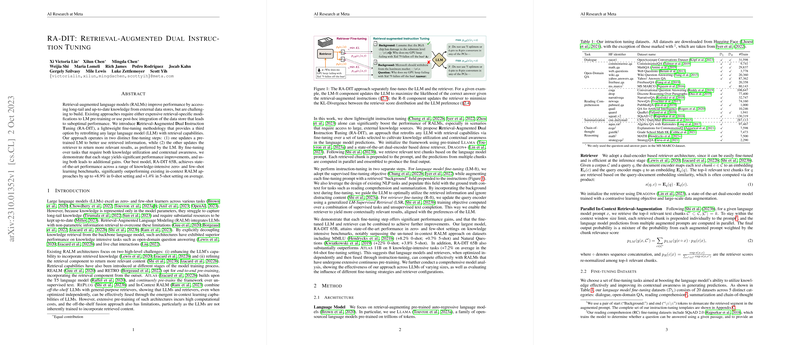A Methodological Advance in Retrieving- and Instruction-Augmented LLMs: An Analysis of RA-DIT
The paper "RA-DIT: Retrieval-Augmented Dual Instruction Tuning" presents a novel methodology for enhancing the capabilities of LLMs by integrating retrieval systems through dual instruction tuning. This work aligns with the recent paradigm shift towards retrieval-augmented LLMs (RALMs), which integrate external knowledge bases with LLMs to access and effectively utilize long-tail and up-to-date information.
Methodology Overview
RA-DIT proposes a two-fold fine-tuning process that modifies both the LLM and the retriever. This approach departs from traditional practices in the RALM domain, which often rely on the complex and computationally intensive pre-training of retrieval-augmented models or the post-hoc integration of LLMs and retrieval systems. RA-DIT instead implements a lightweight, retrofitting methodology allowing any LLM to incorporate retrieval functionalities effectively.
The process begins by fine-tuning the LLM to utilize retrieved information effectively. This phase of dual instruction tuning, labeled as RA-IT, leverages a mix of instruction-following and traditional LLM pre-training data, ensuring that the model can discern and apply relevant external knowledge when tasked. Simultaneously, the retriever is fine-tuned to provide results that align more closely with the LLM's preferences, forming a retrieval component that increasingly returns contextually pertinent data.
A novel mechanical addition to this architecture is the retrieval switch, which intelligently adjudicates between the use of the retrieved content and the LLM's inherent prediction capacity when attempting to respond to certain prompts. This addition ensures a fallback to the LLM's internal knowledge base in scenarios where the retrieval results are deemed suboptimal.
Numerical Analysis and Claims
RA-DIT reports significant empirical improvements over existing retrieval-augmented techniques as measured by the KILT benchmark, among others. Notably, the RA-DIT model delivers superior performance in zero- and few-shot settings compared to its predecessors. For instance, the best-performing RA-DIT 65B model surpassed competing in-context RALM approaches by an average of 8.9% in zero-shot evaluations and 1.4% in five-shot trials. These results underscore its effective integration of retrieval components with LLMs, yielding notable accuracy boosts in knowledge-intensive tasks.
Implications and Future Directions
The impact of RA-DIT extends beyond performance gains. Its methodology suggests a potential shift towards more adaptable and resource-efficient RALM methodologies. By reducing reliance on computationally exhaustive pre-training phases, RA-DIT points towards a future where more rapid adaptation and upscaling of LLM capabilities become plausible across varied application domains.
This work encourages exploration into further iterations of dual-tuning frameworks, including the potential exploration of more granular cross-model optimization steps or the integration with different types of external databases beyond those tested in this paper. Additionally, the quest for fine-tuning universality and robustness continues, inviting further research into refining and perfecting instruction-fine tuning strategies tailored for different domain-specific challenges and corpus configurations.
Overall, RA-DIT introduces critical advancements in refining LLM capabilities and retrieval synergies, setting a benchmark for future endeavors into effective methodologies for instruction-driven and retrieval-augmented LLMs.
